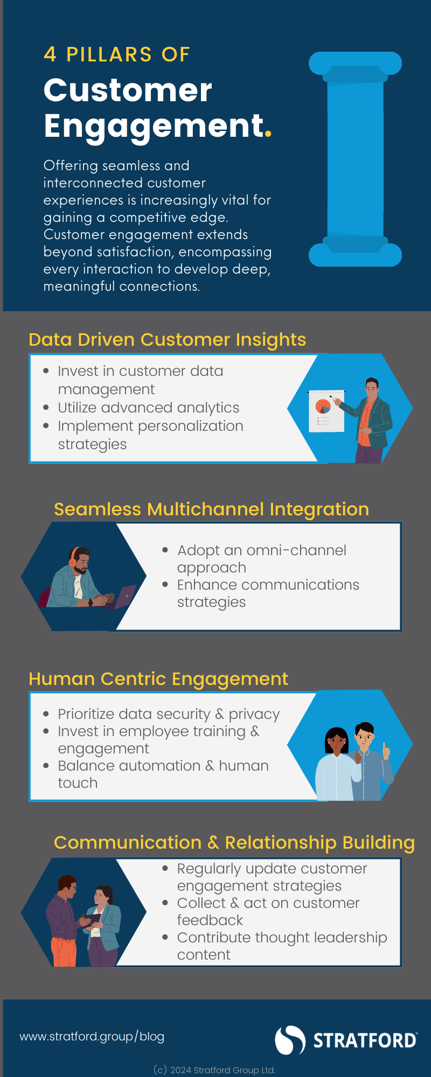Based on our extensive experience, incorporating these four pillars of customer engagement can greatly enhance any engagement strategy. By prioritizing these foundational pillars, you will be able to effectively navigate the challenges of customer engagement and establish a dynamic and customer-centric approach that fosters long-lasting relationships and paves the way for sustainable success.
In the ever-evolving landscape of business, the ability of companies to provide seamless, interconnected experiences rather than isolated, one-time transactions is increasingly becoming a source of competitive advantage. Customer engagement is about developing competencies that go beyond achieving a high-level customer satisfaction with just one isolated product or service to encompass the whole customer experience in every interaction between the company and its customers.
The significance of customer engagement cannot be overstated—it stands as a pivotal factor that can either propel success or pose challenges. Whether operating in a business-to-customer (B2C) framework, a business-to-business (B2B) model, navigating through customer engagement strategically is key.
At the core of a robust customer engagement strategy are four pillars: achieving data-driven customer insights, ensuring seamless multichannel integration, establishing a human-centric engagement approach, and prioritizing communication and relationship building. Each of these pillars encompasses a set of techniques aimed at refining your approach to help you overcome obstacles and cultivate meaningful connections with your customers.
Data-Driven Customer Insights
To have data-driven insights is to empower your business with the ability to tailor strategies and interactions based on valuable insights derived from customer data. This not only allows for a deep understanding of individual preferences but also sets the stage for more targeted marketing campaigns, the anticipation of customer needs, and the improvement of customer retention.
-
- Invest in Customer Data Management: Centralize and manage customer data with a robust CRM system. This serves as the foundation for understanding customer behaviour and tailoring interactions accordingly.
- Utilize Advanced Analytics: Apply analytics tools to convert raw data into actionable insights, enabling a nuanced understanding of customer preferences and trends and the ability to identify cross-selling and upselling opportunities
- Implement Personalization Strategies: Elevate customer experiences by using individual customer data, like preferences and purchase history, to craft personalized communications and services.
Seamless Multichannel Integration
In today's interconnected world, customers interact with businesses through multiple channels, expecting a unified experience across all touchpoints. Seamless multi-channel integration ensures that whether a customer reaches out via social media, email, phone, or in person, they receive a consistent and cohesive experience. This integration is vital for businesses to meet customer expectations at every stage of their journey, enhancing satisfaction and reinforcing loyalty by providing a smooth, hassle-free interaction.
-
- Adopt an Omni-Channel Approach: Ensure consistency across all customer touchpoints, from social media to in-person interactions, to provide a unified and personalized customer journey.
- Enhance Communication Strategies: Maintain clear and consistent messaging across channels to keep customers informed and engaged, leveraging insights from interactions to further personalize the experience.
Human-Centric Engagement
Prioritize personalized interactions and genuine connections over transactions. Human-centric engagement focuses on understanding and addressing the human needs and emotions behind customer interactions. By putting people first, businesses can create memorable experiences that resonate on a personal level, driving deeper engagement and loyalty.
-
- Prioritize Data Security and Privacy: Strengthen trust by safeguarding customer information. Implement robust measures to protect customer information and clearly articulate your commitment to privacy and earning your customers' confidence.
- Invest in Employee Training and Engagement: Cultivate a customer-centric culture through comprehensive employee training. Empower your team to understand the vital role they play in customer satisfaction, promoting a shared commitment to exceptional service.
- Balance Automation and Human Touch: Combine efficient automated processes with the empathetic element of personalized human interaction to meet diverse customer preferences and finding that balance between streamlined processes and genuine connections.

|
Communication and Relationship BuildingEffective communication and relationship building are pivotal in turning casual interactions into lasting relationships. Through clear, consistent, and engaging dialogue, businesses can keep customers informed, address their needs proactively, and build a foundation of trust and loyalty. Beyond just conveying information, this approach involves listening to customer feedback, adapting strategies accordingly. By actively listening to customer needs, responding with empathy, and maintaining an ongoing conversation, businesses can build strong relationships that go beyond the initial sale.
|
Navigating the complexities of customer engagement is crucial for businesses looking to stand out in a competitive environment. By emphasizing these core pillars of engagement data-driven insights, achieving seamless multi-channel integration, embracing a human-centric approach, and focusing on effective communication and relationship building, organizations can significantly improve customer satisfaction and loyalty. These strategies are key to fostering long-term success and growth.
Reach out to our Management Consulting team today to discuss how we can help you integrate these critical customer engagement pillars into your strategic planning, ensuring your business achieves sustained growth and stronger customer connections.
About the Author
A technology enthusiast and senior management consultant, Majd Karam is on the verge of completing her PhD in Digital Transformation and Innovation. With extensive experience in client-facing roles, software requirements workshops, and data analysis, Majd excels in providing innovative solutions. Her unique blend of academic knowledge and industry expertise makes her a valuable asset, offering insights into theoretical frameworks, cutting-edge technologies, and transformative methodologies. Majd's expertise spans analytical thinking, business analysis, user-focused design workshops, and digital technologies alignment. Holding an MBA from the Telfer School of Management and a Bachelor's degree in Computer Information Systems, Majd is dedicated to bridging academic theory and practical business outcomes.
